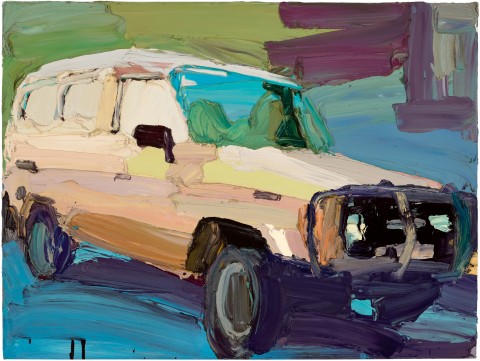AUSTRALIAN LANDSCAPE #1, 2005
BEN QUILTY
oil on canvas
90.0 x 120.0 cm
signed, dated and inscribed with title verso: Australian Landscape No 1 / Quilty / 05
Jan Murphy Gallery, Brisbane
Private collection, Sydney, acquired from the above in 2005
Alex Seton, Ben Quilty, We've Gotta get out of This Place, Jan Murphy Gallery, Brisbane, 29 July – 13 August 2005
Ben Quilty describes this work as Australian Landscape #1, 2005, yet it is the Toyota 4WD Landcruiser that is the actual subject of the painting. Quilty makes his choice of vehicle carefully exploring the landscape and our relationship with it through the cult of the 4WD vehicle. In this instance it reflects a young white male’s desire to identify with the tough talking, hardworking Australian male of the outback. It says, ‘I belong with no-bullshit, can-do real men and with my Toyota, I am connected with the land.’ As a backdrop to the yarns and myths that ferment across the outback, the Toyota Landcruiser parked out the front of the pub pulses with masculine credibility.
Vehicles are not new to Quilty – the Holden XU1 Torana, with its V8 engine crammed under the hood became an early favourite. The Torana entered Australian folk lore in 1972, when Peter Brock drove it to victory against the dominant Ford Falcons at Bathurst’s annual orgy of booze and petrol on Mount Panorama, in the Hardie Ferodo 500. In the decades that followed, the popular Torana (an Aboriginal word meaning ‘to fly’) became the choice of young men when buying their first, second-hand car. By the time Ben Quilty got his Ps, the choice was easy. As time passed his repertoire extended to include Kombis, muscle Fords and 4WDS. Here again, the artist is exploring our relationship to landscape and its importance in shaping the lives of adolescent males through risk-taking rites of passage.
As Lisa Slade suggests, ‘The terrain that the car inhabits, and traverses also interests Quilty. Since he began painting cars, he has been adamant that these paintings also be read as landscapes… Quilty argues convincingly that we rarely experience the landscape without the mediation of the car. In this sense, the car becomes a contemporary Claude glass, a reflective lens that simplifies and synthesises an experience of the landscape that is otherwise too much to bear, too much to restrain into an image.’1
By coincidence or otherwise, the three by four-foot format of this work connects the work directly to a tradition in modern Australian landscape painting. The reason for this format may well be arbitrary as it corresponds to the size the Masonite sheets are made. Nevertheless, conceptually it is a tangible connection to the convention and underpins Quilty’s assertion that what he has painted here is an Australian landscape – albeit an image of a Toyota.
Quilty’s paintings ooze paint and metaphor. His technique of applying paint in broad, thick swathes using baker’s tools results in fleshy surfaces where the paint is literally caked on. The manner of applying paint in moments of driven inspiration may also be understood to reflect the bravado Quilty’s paintings strive to project.
1. Slade, L., ‘Torana Means to Fly’ in Slade, L. (ed.), Ben Quilty – We are History, University of Queensland, Brisbane, 2009, p. 22
HENRY MULHOLLAND

